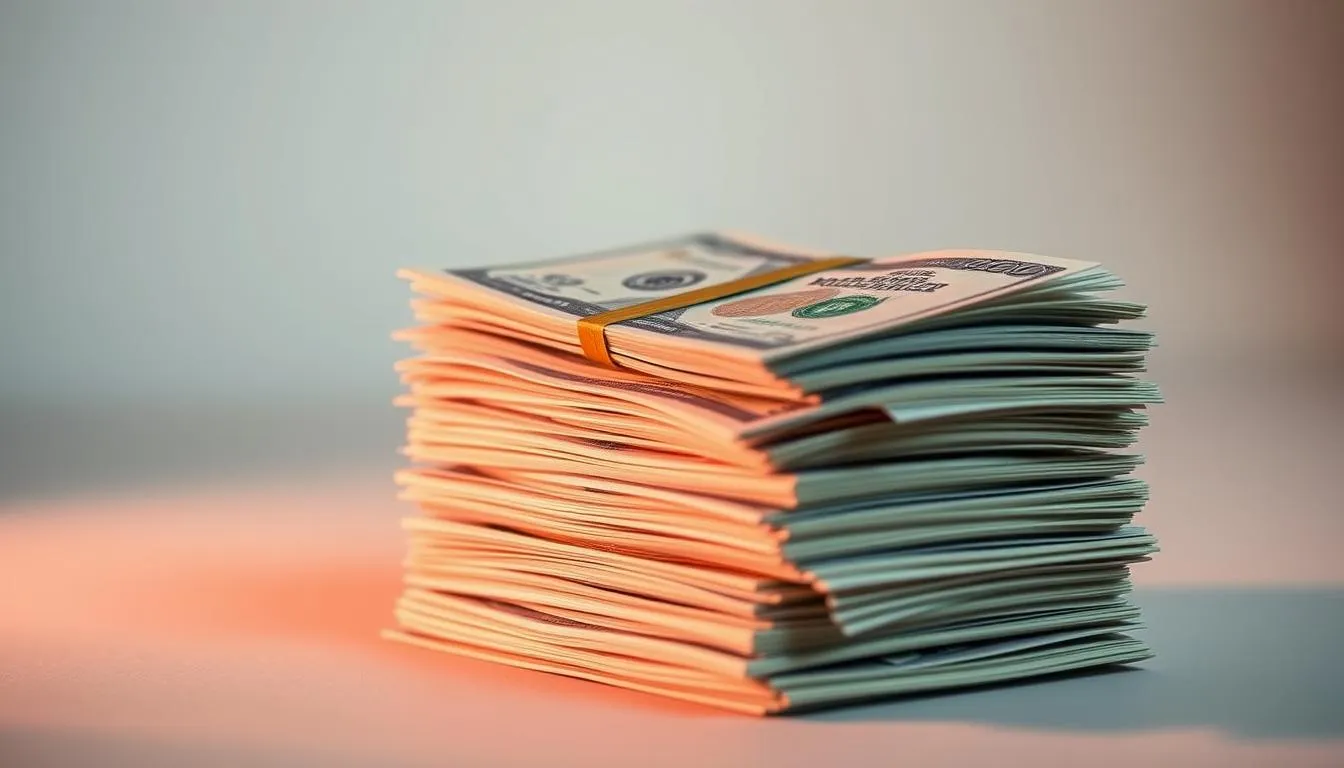Sixty-one percent of adults say they feel more anxious about the economy than a year ago — a shift that helped fuel a spike in what experts call revenge saving.
This pattern is an emotional, accelerated push to build savings after shocks. It shows up now as many people respond to headline-driven jitters and pandemic-era change by hoarding cash for control.
In this short guide, we’ll turn a reactive habit into a calmer, intentional personal finance plan. You’ll learn how to map income and expenses, try reverse budgeting, and build a 3–6 month emergency fund in a high-yield account.
The goal is practical: steady habits that balance living today with preparing for tomorrow. Whether you began saving out of fear, paused your progress, or want a friendly plan, this guide will help you make clear choices that grow over years without burnout.
Key Takeaways
- Revenge saving reflects fear-driven shifts in money habits after the pandemic.
- Simple tools—reverse budgeting and automations—beat emotion-driven reactions.
- Build a 3–6 month emergency fund and separate goal accounts for clarity.
- Small, consistent changes compound over years and reduce anxiety.
- This guide suits beginners, paused savers, and planners seeking steady progress.
Revenge saving in the present economy: what it is, why it’s trending, and who’s doing it
Many households have flipped from public splurges to quietly stockpiling cash as headlines and job swings stoke worry. The shift came after a period of conspicuous spending and now shows up as disciplined buffers and monthly rituals.

From revenge spending to a quieter strategy
After an initial burst of revenge spending, consumers often trimmed non-essentials and moved funds into liquid accounts. That pullback reflects market volatility and higher anxiety about the economy.
Younger generations leading the way
Credit Karma found 44% of adults use “vibe-based budgeting,” with 56% of Gen Z and 57% of Millennials adopting it. Younger generations and side-income earners experiment more with low-spend months, canceled subscriptions, and delayed big purchases.
The psychology: control, loss aversion, and flexibility
Loss aversion and a desire for control motivate many people to build reserves. That flexibility helps cover job or income swings and offers short-term security without permanent lifestyle cuts.
- Who leads: Gen Z, Millennials, high earners, gig workers, and hard-hit communities.
- Practical moves: fewer subscriptions, paused buys, and larger liquid buffers.
- Macro effect: higher household savings can cushion shocks but reduce demand in some sectors.
| Driver | Typical Action | Who | Effect |
|---|---|---|---|
| Headline-driven anxiety | Build emergency buffers | Broad consumers | More household liquidity |
| Loss aversion | Delay big purchases | Younger generations | Lower discretionary demand |
| Income volatility | Keep separate goal accounts | Gig & side earners | Faster access to cash |
For a deeper look at the shift and its implications, see the new trend in personal finance. Next, we’ll turn this emotional push into a practical plan for steady progress.
How to stop revenge saving on autopilot and start saving with intention
Start by taking a clear snapshot of your cash flow so choices feel intentional instead of reactive.
Take your money temperature: map income, fixed bills, and variable expenses
List every income source and your regular bills. Include rent, utilities, subscriptions, and typical groceries.
This quick inventory shows where to trim and what core expenses a future emergency fund must cover.
Use reverse budgeting: pay yourself first toward short- and long-term goals
Set goals first. Route a set amount to a savings account and retirement plans before monthly wants.

Build an emergency fund of three to six months in a high-yield savings account
Target three to six months of core expenses and keep that fund liquid in a high-yield savings account.
Create separate accounts and automate transfers for goals
Use dedicated accounts for emergency, short-term goals, and retirement. Label each so progress is visible.
Plan periodic contribution increases to keep momentum without burnout
Ask your employer to raise workplace plan contributions by 1% annually or set your own auto-increases.
Small steps compound and avoid the fatigue of big cuts.
| Action | Where to put it | Why it helps |
|---|---|---|
| Monthly core buffer | High-yield savings account | Liquidity + modest interest |
| Retirement contributions | 401(k) or IRA | Tax-advantaged growth |
| Short-term goals | Dedicated savings account | Clear targets and less temptation |
- Review your money temperature quarterly and after any income or job change.
- Automate payments, auto-increase contributions, and label accounts by goals.
- Stay flexible: adjust plans if income shifts while protecting the emergency fund.
Tools, accounts, and rate strategies to make saving easier and more rewarding
Smart rate strategies and goal-oriented accounts help your money work harder while you sleep.
 Pick a high-yield savings account as the primary home for your emergency funds. These accounts offer liquidity and competitive APYs, so you earn more interest without locking up access when life happens.
Pick a high-yield savings account as the primary home for your emergency funds. These accounts offer liquidity and competitive APYs, so you earn more interest without locking up access when life happens.
Use retirement plans and IRAs to grow long-term
Workplace plans and IRAs put long-term dollars to work with tax advantages and diversified investment options. Consider automatic escalation of contributions—Fidelity recommends small annual boosts—to keep retirement progress steady.
Automate and visualize progress with goal tools
Digital banking tools can split accounts, label buckets, and move money on a schedule. That visible momentum helps consumers stick to plans and reduces impulse moves.
“Compare products carefully—some prioritize liquidity, others higher rates with limits.”
- Match each product to its goal: liquid accounts for emergencies, CDs or hybrids for higher rates on idle funds.
- Monitor rates and shift only funds that won’t impair access to core accounts.
- Ask financial advisors about balancing cash, investment risk, and tax-efficient sequencing across plans.
Build a simple dashboard—your bank app or a spreadsheet—to track accounts, funds, and milestones without overcomplicating personal finance.
Make it sustainable: avoid emotional extremes and common pitfalls
Sensible routines help you keep financial security without missing life’s small joys. Temper the impulse to react and pair emotion with a simple plan. That reduces whiplash choices that harm well-being.
Don’t let emotions drive every choice: balance security with living your life
Channel anxiety into repeatable steps: an emergency bucket, labeled accounts, and clear priorities. Use automation so good habits carry you through uncertain times.
Set non-negotiable lines for core expenses and one account for short-term joy. That keeps savings from crowding out daily life.
Watch for plateaus and excess cash drag; revisit allocations as rates and goals change
Analysts warn of excess liquidity in low-yield products. Keep enough liquid emergency funds, but move long-term funds where they can grow.
Quarterly check-ins or twice-yearly reviews help you catch a savings plateau. Trim expenses, refresh automations, and reallocate funds as priorities or rates shift.
- Protect access: keep a clear emergency buffer, then optimize other funds.
- Schedule reviews: quarterly or semiannual account audits avoid drift.
- Ask for help: consult financial advisors when choices between cash and investments are unclear.
Expect ups and downs. Make the habit sustainable by defining what matters now and over the years. Let your plan — not headlines — guide practical adjustments.
Conclusion
Move from reaction to routine by choosing one product and one auto-transfer to start today.
Channel the energy, set a clear goal, and build or top off a three- to six-month emergency fund in a high-yield savings account.
Label accounts by goals, automate contributions, and revisit allocations after any job or income change. Balance short bursts of urgency with steady habits so progress lasts for years. When choices get complex, ask financial advisors for guidance on contribution levels, investment steps, and product trade-offs.
Action: pick one account or tool now, set an auto-transfer, and let automation carry the work while you live your life.
FAQ
What is this trend of switching from impulse spending to deliberate saving?
It’s a shift where people replace splurges with targeted cash-building strategies after economic shocks. Instead of buying to cope, many now prioritize short-term liquidity and long-term goals, using tools like high-yield savings accounts, IRAs, and workplace plans to regain control amid uncertainty.
Who is most likely to adopt this cautious money approach?
Younger adults—Millennials and Gen Z—are leading the move. They faced job instability and market swings early in their careers, which pushed them to embrace vibe-based budgeting, emergency funds, and automated transfers to balance lifestyle and security.
What psychological drivers make people switch from spending to hoarding cash?
Key factors include loss aversion and a desire for control. After seeing markets fall or jobs change, consumers prioritize flexibility and safety. Building a buffer reduces anxiety and gives choices when markets or personal circumstances shift.
How do I assess my current financial state to start saving intentionally?
Map your monthly take-home pay, fixed bills, and variable expenses. Identify discretionary categories you can trim and set clear target amounts for an emergency cushion and other goals. A simple spreadsheet or budgeting app helps clarify where funds can be redirected smartly.
What is reverse budgeting and how can it help me meet goals?
Reverse budgeting means paying yourself first. Set up automatic transfers to dedicated accounts for emergencies, retirement, and goals before you cover discretionary spending. This keeps progress steady and reduces the temptation to overspend.
How large should my emergency fund be and where should I keep it?
Aim for three to six months of essential expenses in a liquid, insured account. A high-yield savings account is a popular choice because it offers easy access plus competitive rates that outpace traditional savings.
Should I use multiple accounts for different goals?
Yes. Separate accounts for short-term buffers, a down payment, and retirement (401(k), IRA) make progress visible and reduce the temptation to dip into long-term savings. Automation ties the plan together and keeps contributions consistent.
How often should I revisit my allocations and contribution levels?
Review allocations at least twice a year and after major life events like a job change or market downturn. Consider modest automatic increases to contributions annually to keep pace with income growth without causing burnout.
What banking and investment tools should I consider to balance liquidity and growth?
Use high-yield savings for near-term liquidity, a brokerage or Roth IRA for tax-advantaged investing, and employer 401(k) plans for long-term retirement with potential employer matches. Goal-based apps can visualize progress and encourage consistency.
How can I avoid the trap of hoarding cash that underperforms over time?
Monitor interest rates and inflation, and move excess funds into higher-yield options or diversified investments once your emergency cushion is solid. Revisit allocations when rates change or when you hit savings milestones to prevent cash drag.
What mistakes do financial advisors often see with this cautious approach?
Common errors include keeping too much in low-rate accounts, failing to invest for long-term goals, and letting fear freeze action. Advisors recommend balancing a secure emergency fund with retirement and investment plans to avoid missing market growth.
How do I balance enjoying life now while building financial security?
Set a realistic budget that includes fun money. Automate savings first, then allocate a steady portion for discretionary spending. That way you maintain quality of life while steadily building resilience and future options.
